Strength Training for Volleyball Players (Detailed Program)
Author:
Reviewed by:
(21 years of Oly Lifting experience)
Unlock your full potential by engaging with our experts and community! Have questions about your fitness journey or looking for expert advice on weightlifting techniques? Don’t hesitate — leave a comment below and Sergii Putsov will provide a personalized answer and insights to help you reach your goals.
Torokhtiy is reader-supported. Some links are affiliate links, and we may earn a commission at no extra cost to you. See our disclosure page for details.
Are you a volleyball player looking to gain an edge over the competition? Strength training for volleyball can help boost your power and intensity on the court. In this article, we’ll explain why and how a volleyball weight lifting program is essential and how it can be incorporated for the best results.
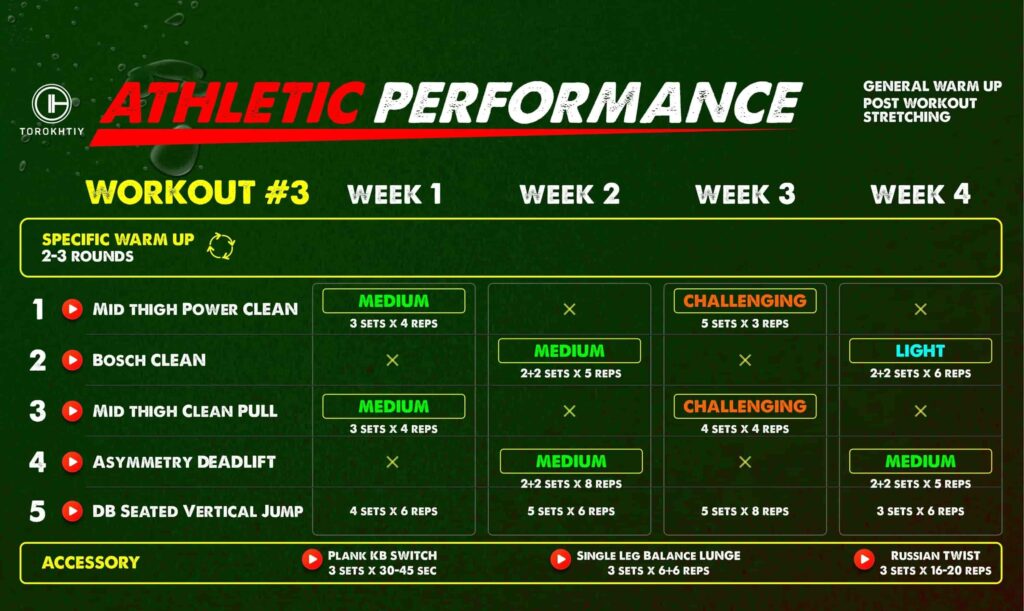
A volleyball weight-lifting program is a routine that focuses on building strength, power, and endurance in the muscles used to play the sport. It typically consists of squats, deadlifts, bench presses, and shoulder presses, performed with free weights or machines.
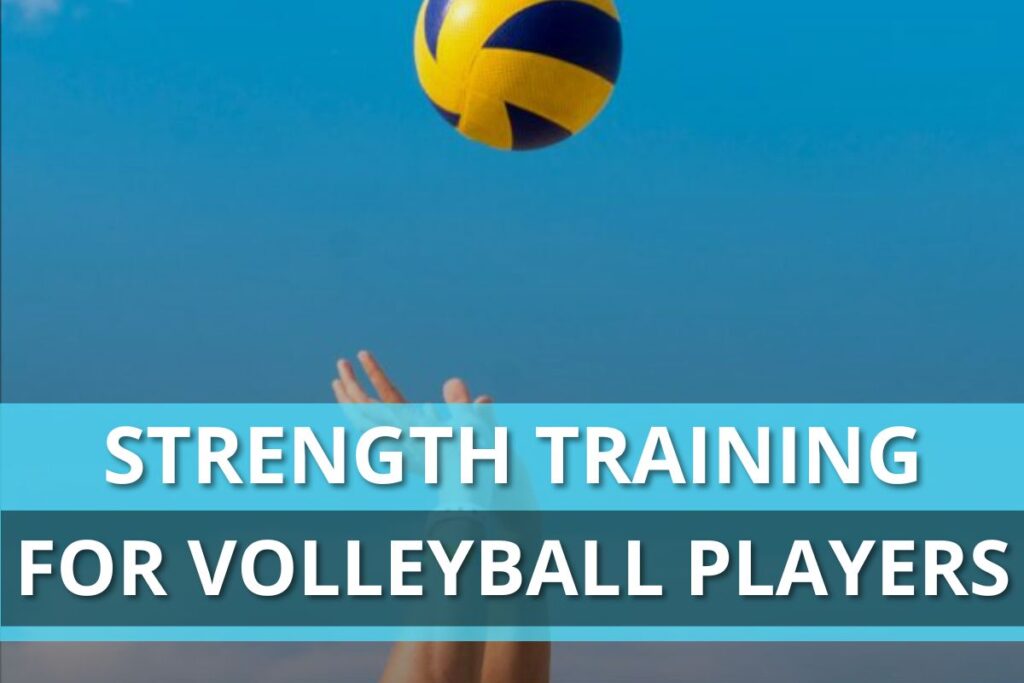
What’s Strength Training for Volleyball Players
Strength training for volleyball players is essential to improve muscle strength, explosive power, and core stability while reducing the risk of injury.
Various strength training workouts can concentrate on specific muscles and boost optimal performance, such as squats, deadlifts, presses, and lunges.
Regarding strength training, it is essential to consider factors such as intensity level, reps, sets, rest periods, and weight.
Benefits of Strength Training For Volleyball Players
A volleyball weight lifting program has a lot of benefits for volleyball athletes. Volleyball-specific strength and conditioning programs improve overall athletic performance and power development.
Let’s take a look at some of the main benefits below:
Increased Power and Explosiveness
Weight training for volleyball players can help to increase power and explosiveness on the court. This will help you to jump higher, hit the ball harder and faster, and move more quickly around the court.
Improved Core Strength
Strengthening your core muscles is essential for volleyball players. Core exercises such as planks can help to build a strong base that can increase power and stability on the court.
Improved Coordination and Balance
Agility drills can help improve coordination, balance, and equilibrium. These exercises involve quick changes in direction, which can help enhance court performance.
Reduced Risk of Injury
Strength training can also reduce the risk of injury by increasing muscle strength, stability, and flexibility. This will help to protect players from common volleyball injuries such as sprains, strains, and tendonitis.
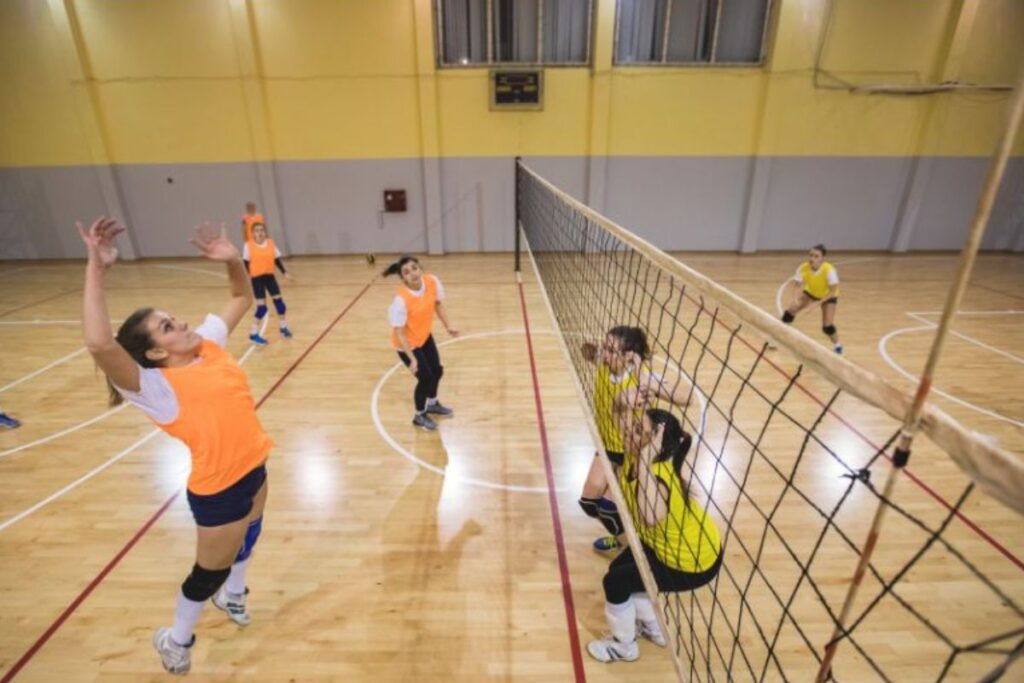
Strength Training Exercises for Volleyball Players
A volleyball strength training program should focus on muscle groups such as the quads, hamstrings, glutes, lats, chest, and core.
Let’s look at some of the best exercises for a volleyball weight training program:
Hang Clean
Hang cleans is an excellent compound exercise that works the major muscles of both the upper and lower body, such as the glutes, quads, hamstrings, and back muscles.
Begin by gripping the bar slightly wider than an athletic stance, slightly above your knees, with your back locked in, shoulders up, and chest flexed. Then explosively jump up using your hips, knees, and ankles while keeping the bar close to your chest.
Finally, drop under the bar so it catches along at the front of the shoulders in an athletic stance with knees bent.
The barbell is then raised from the shoulder until it is directly above your head, this aspect of the movement is known as the jerk.
Forward Lunge
The Dumbbell Forward Lunge is an effective lower-body exercise that develops lower-limb explosive performance, mobility, and stability. It is performed by holding a set of dumbbells at your sides and then stepping forward into a lunge position without allowing the knee to touch the ground.
Using your front foot, gradually push back into a standing position before switching legs and repeating for the specified reps.
Keeping your back flat and chest up is essential to engage the proper muscle groups. Avoid overstriding on the lunge or allowing your knee to touch the ground during each rep, as this may cause injury or discomfort over time.
Military Press
The military press helps build strength and power performance while engaging ‘secondary movers’ such as the triceps, mid-back, and chest: the shoulders, triceps, and upper back.
Stand with feet slightly under the chin, gripping the bar at shoulder width apart and lifting off from the rack.
Next, drive the bar directly overhead until the arms are straight, but the elbows remain slightly bent at the movement’s top to protect the joints. Repeat once you’ve returned to the beginning position.
Single-Arm Dumbbell Snatch
The single-arm dumbbell snatch is a great exercise for testing and building strength and power. It involves forcefully pressing off the ground with a jumping movement while extending the ankles, knees, and hips to lift a single dumbbell up and over the shoulder.
Start with your feet shoulder-width apart in an athletic stance. Hold the dumbbell in one hand between your knees and squat slightly before quickly pressing off the ground with a jumping movement.
This momentum will help drive the weight forward, allowing you to pull it up over your shoulder and hold it fully extended for one second before lowering back down.
Biceps with Overhead Press
The overhead press is one of the best exercises to include in weight lifting for volleyball as it helps in developing the biceps and preventing shoulder injuries in volleyball while increasing strength and explosiveness in arm swings.
To do a proper overhead press, stand with your feet roughly shoulder width apart with a kettlebell or barbell held at chest level.
Push upward over your head until your arms are nearly straightened out, and hold before releasing back down with control.
Barbell Squats
Barbell Squats are essential to any volleyball strength training program as it engages multiple muscle groups.
Begin by positioning your feet slightly wider than shoulder-width apart. Lowing into a squat position, keep your chest up, back straight, and knees over your toes.
Push back up to the starting position and repeat for desired reps.
Critical Factors in Volleyball Players’ Strength Training Routine
Strength training for volleyball players should be tailored to their individual needs and goals.
It is essential to understand that the type of strength training you do will depend on your current level of fitness, as well as the specific goals you want to achieve.
Here are some of the critical factors to keep in mind when weight training for volleyball.
Core Strength
A strong core is essential for any volleyball player, providing the foundation for power production and stability. Core training should focus on exercises that target all areas of the abdomen, lower back, and glutes.
Follow us!

Free!
Get a 2-week Weightlifting Program as a bonus for the subscription to kickstart your training plan!

Free!
Upper Body Strength
Upper body work should be essential to any volleyball player’s strength training routine. Lifting weights, pulling and pushing-ups, or resistance training exercises will build upper-body strength.
Strengthening your arms and shoulders provides more stability when leaping high to reach a spike or diving across the court after a dig attempt.
Lower Body Strength
Volleyball is a rapid game with lots of lateral movement, so having an explosive lower body is critical to success.
Lower body exercises such as squats, step-ups, and split squats will help build strength in the legs while strengthening your core. In contrast, Plyometric exercises like box jumps are suitable for developing peak speed.
Cardio Endurance
Every successful volleyball player must have well-rounded endurance, not just in terms of muscular endurance, but cardiovascular conditioning.
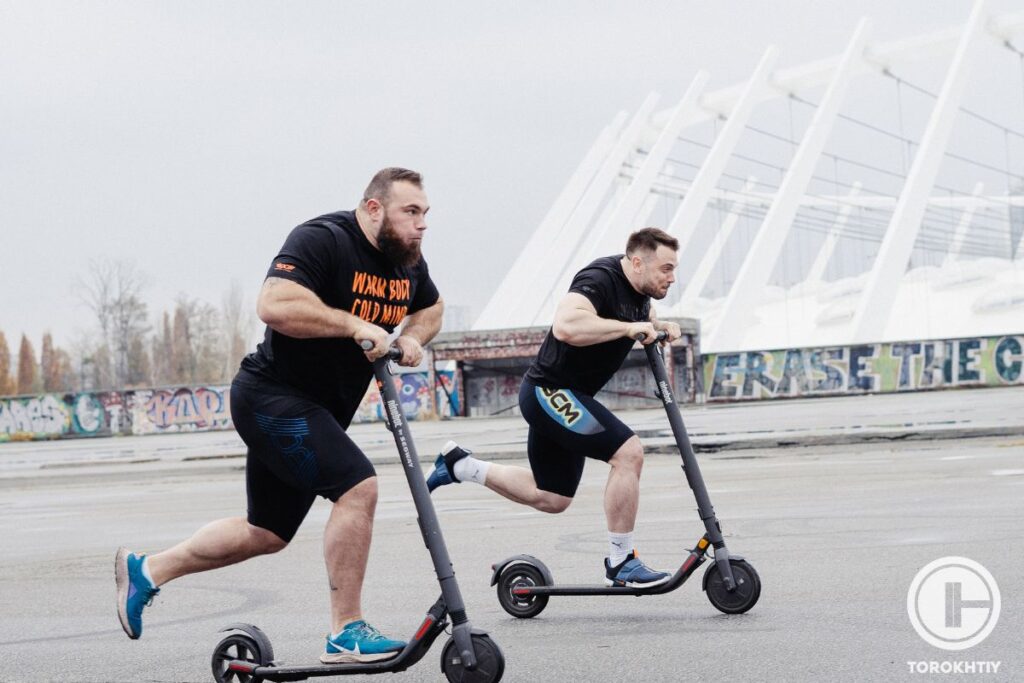
Keeping cardio endurance sessions short, but intense keeps your body ready for specific activity patterns at any given moment on the court vital for repeat bursts or agility moves during gameplay.
Volleyball Players Strength Training Programming
A volleyball strength training program should focus on muscle groups such as the quads, hamstrings, glutes, lats, chest, and core. Squats and deadlifts are great exercises for the quads, while hamstring curls and glute bridges benefit the hamstrings and glutes.
Plyometrics is another form of strength training that involves quick, explosive movements like jumping, bounding, and hopping. These exercises help to improve power, speed, agility, and coordination on the court.
Agility drills can also help to improve coordination and reaction time while increasing balance and stability. These exercises involve quick changes in direction, such as side shuffles and carioca drills, which can help to improve on-court performance.
Bent-over rows, pull-ups, and push-ups are suitable for the lats and chest, while planks can help strengthen the core.
Here’s a 3-day training program example for volleyball players:
Day 1: Upper Body Power and Strength
1. Military Press: 4 sets x 6-8 reps
Focus on explosive upward movement with proper form
2. Biceps with Overhead Press: 3 sets x 8 reps
Emphasize control during the bicep curl and press
3. Single-Arm Dumbbell Snatch: 3 sets x 5 reps per arm
Focus on explosive hip drive and controlled catch
4. Anti-Rotational Lat Pull: 3 sets x 8 reps per side
Emphasize stability and controlled movement
Day 2: Lower Body Power and Explosiveness
1. Hang Clean: 3 sets x 4 reps
Focus on explosive hip drive and full extension
2. Back Squats: 4 sets x 8 reps
Emphasize depth and explosive upward movement
3. Dumbbell Forward Lunge: 3 sets x 10 reps per leg
Maintain a full range of motion with controlled movement
4. Box Jump: 3 sets x 5 reps
Emphasize explosive jump with soft landing
Save it for easy access!
Bookmark this page now to access the program and instructional videos anytime, anywhere.
Stop wasting time searching during your gym sessions.
Day 3: Core and Functional Training
1. Atomic Landmine Rotations: 3 sets x 8 reps per side
Focus on rotational power and stability
2. Paloff Press: 3 sets x 10 reps per side
Maintain core engagement against resistance
3. Adductor Plank Raise: 3 sets x 30 seconds per side
Emphasize stability and balance
4. Plank Kettlebell Switch: 3 sets x 8 reps
Focus on core stability during the switch
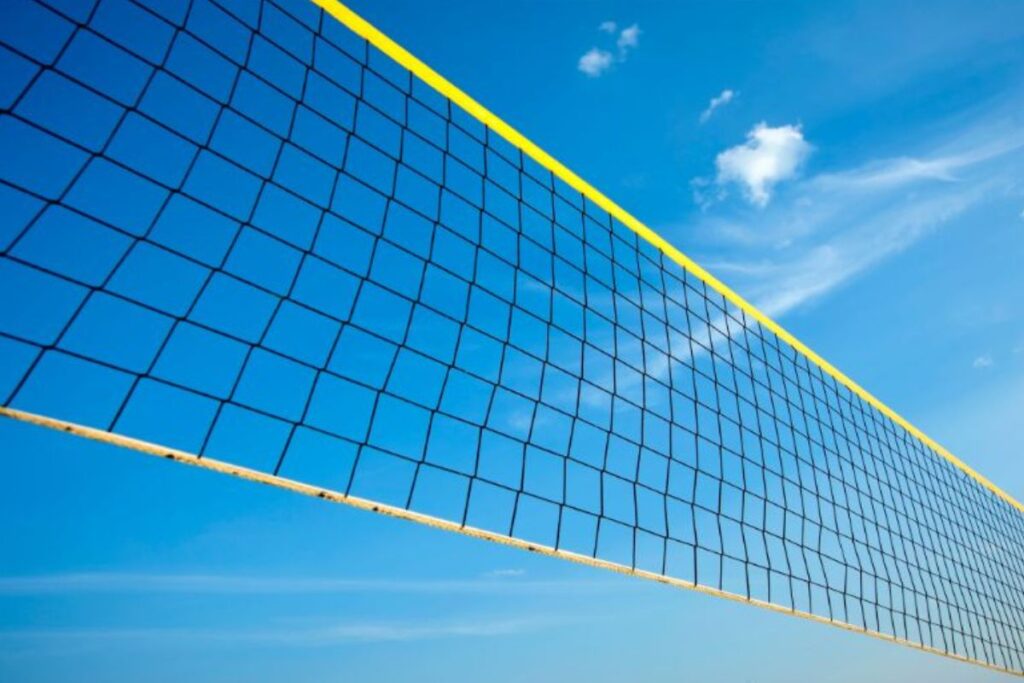
Volume and Intensity Guidelines:
Warm-Up: Begin each session with dynamic mobility and activation exercises.
Rest Intervals: Take 2 minutes between compound lifts and 1-1.5 minutes for accessory exercises.
Load: Start at 50-60% of maximum capacity and progressively increase the load.
Accessory Exercises: Use moderate weights with a focus on form and stability.
Mobility and Recovery Tips:
- Incorporate hip, shoulder, and ankle mobility exercises.
- Use foam rolling and stretching to alleviate muscle tension.
- Prioritize sleep, hydration, and nutrition for recovery.
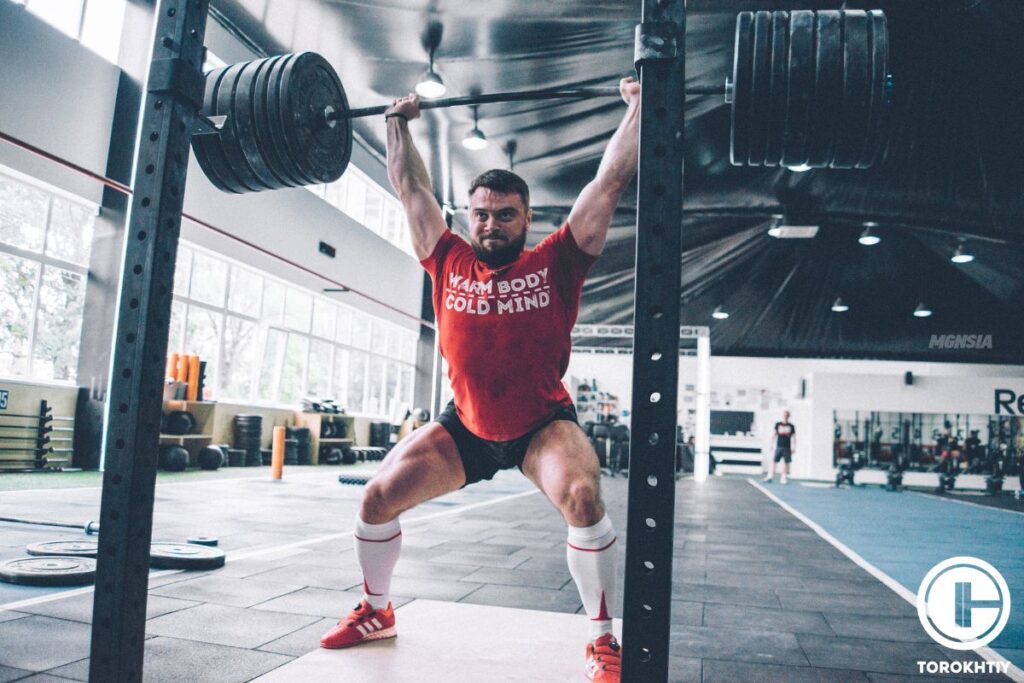
Basic Equipment You Need
A volleyball weight-lifting program can successfully be achieved with some essential equipment.
- Weights: Kettlebells, barbells, and dumbbells are all great options essential to any strength training routine.
- Bands: Resistance bands can be used to promote flexibility while also enhancing strength and stability.
- Medicine Balls: Medicine balls are great for explosive exercises that target the core and lower body.
- Agility Ladder: Enhance your footwork and coordination on the court by using an agility ladder.
FAQ
What Lifts Are Best for Volleyball Players?
Strength training for volleyball players should focus on building power and overall explosiveness. Exercises such as squats, deadlifts, pull-ups, push-ups, bent-over rows, and plyometrics are great for building strength.
Medicine ball exercises can also be beneficial in building core strength, while agility drills help to improve coordination and reaction time.
Does Weight-Lifting Help Volleyball Players?
Weight-lifting can be a great way to improve overall performance for volleyball players. Building strength and power through weight-lifting can help volleyball players become more explosive on the court while also helping to increase their agility and coordination.
Additionally, weight-lifting can help develop the core muscles essential for stability and balance when jumping or diving across the court.
How Often Should a Volleyball Player Lift Weights?
It’s suggested that volleyball players should lift weights at least two to three times a week.
However, your workouts’ exact frequency and duration should depend on your individual goals and abilities. When starting, it’s important to gradually build up your strength with light weights before progressing to heavier ones.
Conclusion
In conclusion, strength training for volleyball players can benefit their overall performance. Developing upper and lower body strength and cardio endurance can help players become faster, more powerful, and more agile on the court.
Are you a volleyball player who’s started a weight-lifting program? Let us know what exercises work best for you in the comments below!
Also read:
- Strength Training for Cyclists
- Bjj Lifting Program
- Golf Strength Exercises
- Military Style Workout Routine
- Strength Training for Swimmers
- Strength Training for Soccer Players
- Strength Training for Boxers
- Medicine Ball Guide
References:
- Strength and Conditioning in Volleyball // USA Volleyball: https://usavolleyball.org/resource/strength-and-conditioning-in-volleyball/
- The Average Guy’s Guide to Olympic Lifting // Men’s Health: https://www.menshealth.com/fitness/a25350394/olympic-lifts-for-beginners/
- PLYOMETRICS: DEVELOPING POWER WITH PLYOMETRIC EXERCISES // NASM: https://blog.nasm.org/fitness/developing-power-in-everyday-athletes-with-plyometrics
- Military Press: Benefits, Muscles Used, and More // Inspire USA Foundation: https://www.inspireusafoundation.org/military-press/
- THE MUSCLES USED IN SQUATS – SQUAT BIOMECHANICS EXPLAINED // NASM: https://blog.nasm.org/biomechanics-of-the-squat
- Photos by Torokhtiy Media Team; alexytrener, Canva.com; miodrag ignjatovich, Canva.com; zaemiel, Canva.com.
Why Trust Us?
With over 20 years in Olympic weightlifting, strength training, nutrition coaching, and general fitness our team does its best to provide the audience with ultimate support and meet the needs and requirements of advanced athletes and professional lifters, as well as people who strive to open new opportunities and develop their physical capabilities with us.
By trusting the recommendations of our certified experts in coaching, nutrition, and sports training programming, as well as scientific consultants, and physiotherapists, we provide you with thorough, well-considered, and scientifically proven content. All the information given in the articles concerning workout programming, separate exercises, and athletic performance, in general, is based on verified data.
The product testing process is described in more detail here.
Author: Sergii Putsov
Head of Sport Science, PhD
Best Results: Snatch – 165 kg,
C&J – 200 kg
Sergii Putsov, Ph.D., is a former professional weightlifter and National team member, achieving multiple medals in the 94 kg weight category at national competitions. With a Master’s degree in “Olympic & Professional Sport Training” and a Sport Science Ph.D. from the International Olympic Academy, Greece, Sergii now leads as the Head of Sport Science. He specializes in designing training programs, writing insightful blog articles, providing live commentary at international weightlifting events, and conducting educational seminars worldwide alongside Olympic weightlifting expert Oleksiy Torokhtiy.
Reviewed by: Oleksiy Torokhtiy
Olympic Weightlifting Champion, PhD in Sport Science
Best Results: Snatch – 200 kg,
C&J – 240 kg
Oleksiy Torokhtiy is a professional athlete boasting 20 years of experience in Olympic weightlifting. With multiple European and World titles under his belt, he has showcased his prowess in two Olympic Games (Beijing 2008 and London 2012). Upon concluding his illustrious career, Oleksiy dedicated himself to coaching. By 2022, he had conducted over 200 weightlifting seminars worldwide. He is the visionary behind an international sportswear and accessories brand known for its motto, “Warm Body Cold Mind.” Additionally, he is an esteemed author and the creator of a series of training programs and eBooks.




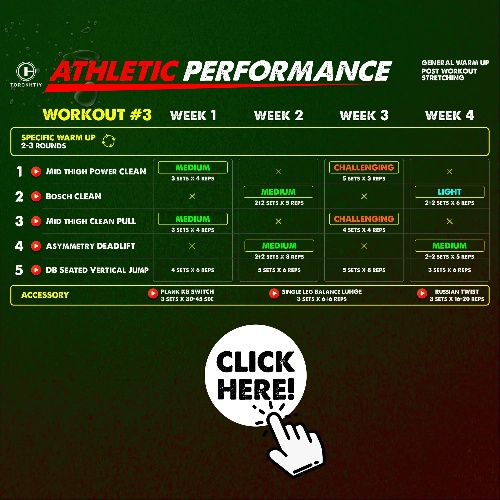

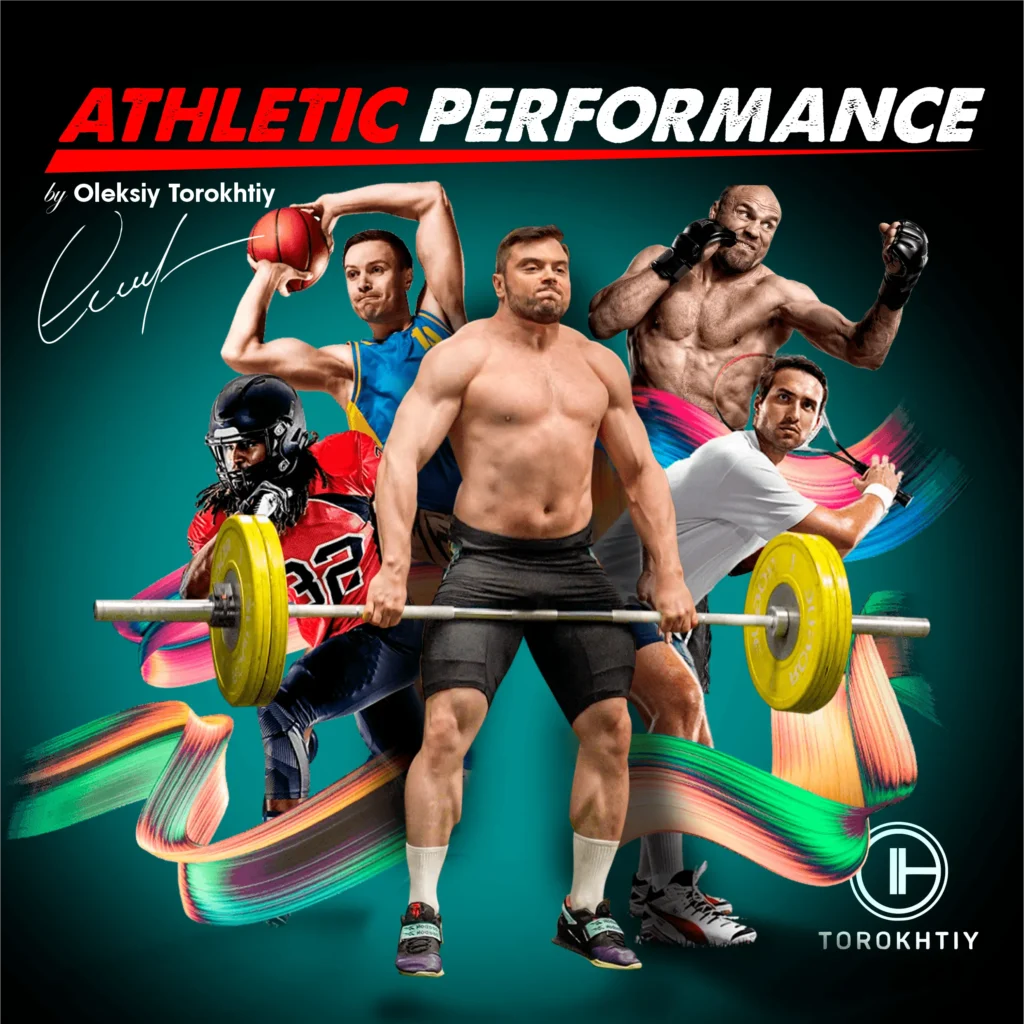
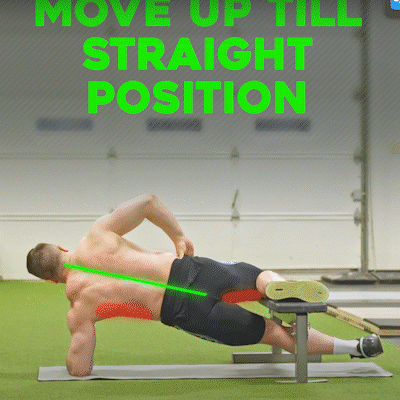
Still have questions after reading our article? Unlock your full potential by engaging with our experts and community! Don’t hesitate — leave a comment below and Sergii Putsov will provide a personalized answer and insights to help you reach your goals.